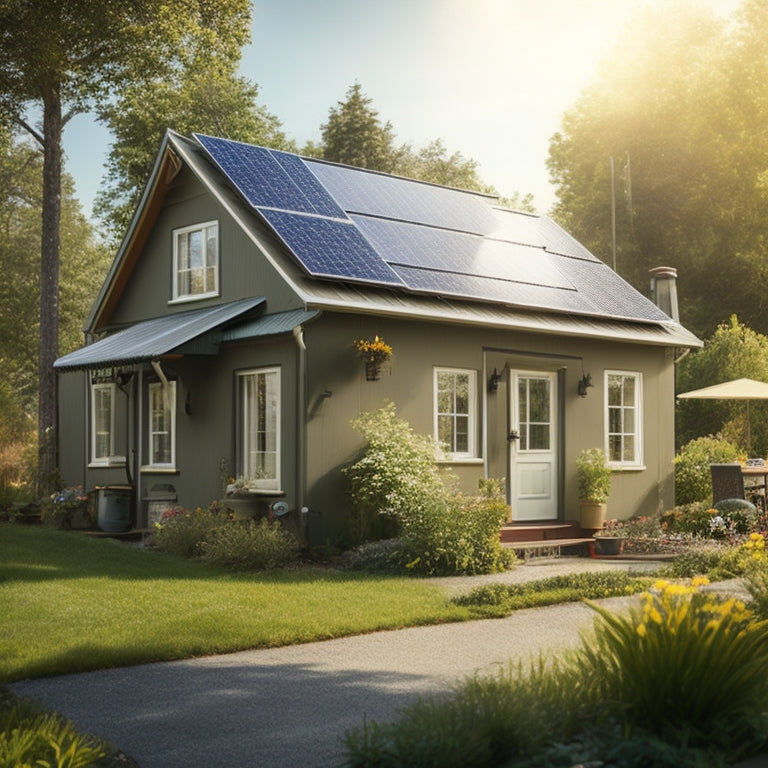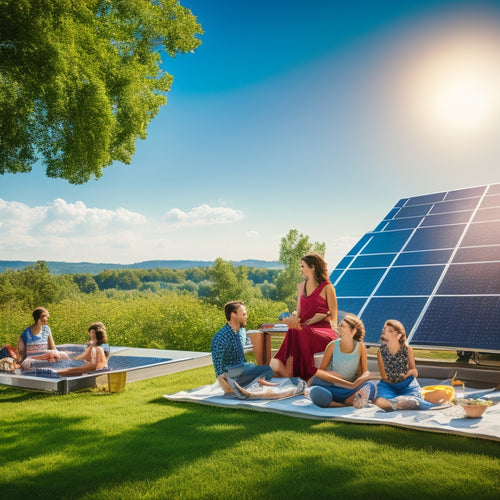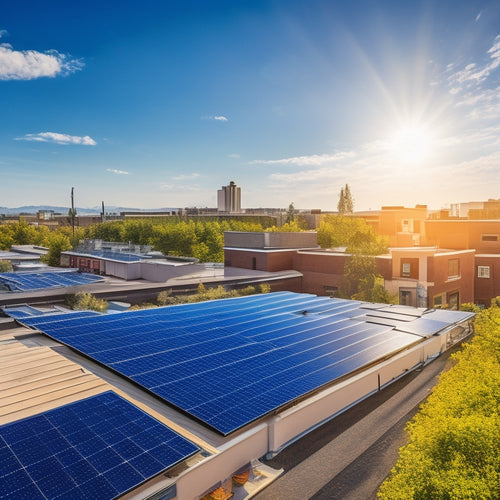
10 Essential Tips for Small Home Solar Installation
Share
For small home solar installations, first evaluate your energy needs to determine system size. Choose high-efficiency panels suitable for limited space and make sure your roof can support them with ideal orientation for sunlight. Factor in federal and state incentives to reduce upfront costs. Hire certified installers and use quality components for reliability and safety. Regular maintenance will maintain efficiency. Investigate battery storage for off-grid capabilities and energy independence. Don't forget local regulations, permits, and HOA rules. By considering these essential tips, you'll maximize your solar investment and harness the full benefits of renewable energy. Discover more detailed guidance ahead.
Key Takeaways
- Choose High-Efficiency Panels: Opt for high-efficiency solar panels to maximize energy output, especially if roof space is limited.
- Assess Roof Suitability: Ensure your roof is compatible, structurally sound, and oriented for optimal sunlight exposure.
- Utilize Financial Incentives: Leverage federal tax credits and state rebates to reduce upfront installation costs.
- Hire Certified Installers: Use certified professionals to ensure proper installation, compliance, and warranty protection.
- Consider Battery Storage: Invest in battery storage to store excess energy, enhance energy independence, and manage peak demand charges.
Assess Your Energy Needs
https://www.youtube.com/watch?v=khYZTmm7S5I
Why start your solar journey without first understanding exactly how much energy your household consumes? Knowing your energy consumption patterns isn't just a preliminary step; it's the cornerstone of an efficient and effective solar installation.
Analyze your utility bills over the past year to grasp your monthly and seasonal energy usage. This data helps you determine the size and capacity of the solar system you'll need.
Pay special attention to peak hours—times when your energy use spikes. Typically, these hours fall in the late afternoon and early evening, but they can vary based on your lifestyle.
By identifying these high-demand times, you can optimize your solar system to either store energy for later use or offset peak usage with real-time solar power generation.
Understanding your energy needs liberates you from the grip of fluctuating utility rates and empowers you to design a system tailored to your lifestyle. It also ensures that you won't over-invest in unnecessary capacity or, worse, under-invest and fail to meet your energy needs.
Precision in this step guarantees that your shift to solar energy isn't just sustainable but also economically wise.
Choose the Right Panels
Having assessed your energy needs, the next step is to choose the right panels that match your consumption patterns and maximize efficiency. Panel efficiency is critical; it determines how much sunlight is converted into usable electricity. Higher efficiency panels tend to cost more but can offer greater energy output, allowing you to generate more power from a smaller footprint.
When evaluating panels, consider the following:
-
Panel Efficiency: Look for panels with high efficiency ratings, typically between 15% and 22%. Higher efficiency panels are ideal if you have limited roof space but still want to meet high energy demands.
-
Warranty Terms: Pay close attention to warranty terms. A robust warranty, often 20 to 25 years, safeguards your investment. It reflects the manufacturer's confidence in their product's durability and performance.
-
Type of Panels: Choose between monocrystalline, polycrystalline, and thin-film panels. Monocrystalline panels are the most efficient but also the most expensive. Polycrystalline panels offer a good balance between cost and efficiency. Thin-film panels are less efficient but can be a viable option for larger installations where space isn't a constraint.
Evaluate Roof Suitability
Evaluating your roof's suitability is essential for guaranteeing peak solar panel performance and longevity. Start by analyzing your roof material; some materials like asphalt shingles and metal roofs are more compatible with solar panels. These materials provide a sturdy foundation and generally require less retrofitting.
Next, consider your roof's structural integrity. Solar panels add weight, and your roof must support this additional load without compromising safety. Hire a professional to inspect the rafters and trusses for any signs of wear or damage. Reinforcing your roof might be necessary to meet the load requirements, especially if your home is older.
Orientation and tilt also play a significant role. Ideally, your roof should face south for maximum sunlight exposure. The angle of your roof should align closely with your latitude, but adjustable mounts can optimize the tilt if needed.
Lastly, evaluate the roof's age. If it's nearing the end of its lifespan, replacing it before installation will save you future hassle and expense.
Understand Solar Incentives
Make sure you're aware of the federal tax credits available, which can greatly reduce your installation costs.
Additionally, investigate state rebate programs specific to your location, as they offer further financial incentives.
These benefits can make solar installation more affordable and improve your return on investment.
Federal Tax Credits
Understanding federal tax credits is crucial for maximizing the financial benefits of your small home solar installation. Federal tax credits can greatly reduce the cost of your solar project, but you must be aware of tax eligibility and credit deadlines to take full advantage.
The Federal Solar Investment Tax Credit (ITC) allows you to deduct a portion of your solar costs from your federal taxes. As of now, the ITC offers a 26% tax credit for systems installed by the end of 2022, and this percentage slightly drops in subsequent years.
To make sure you're eligible, your solar system must be installed on your primary or secondary residence in the U.S. and be fully operational by the end of the tax year. Keep an eye on the credit deadlines to make sure you don't miss out on the maximum benefits.
Here are some key points to remember:
-
Tax eligibility: Your solar installation must meet specific criteria to qualify for the ITC.
-
Credit deadlines: Act promptly to maximize your tax savings before the percentage decreases.
-
Documentation: Maintain thorough records and receipts to claim your credits without any issues.
State Rebates Programs
Understanding state rebate programs can greatly improve the financial viability of your small home solar installation. These programs offer substantial financial incentives that can greatly reduce your initial costs. Each state has its own set of rebate programs, and managing them requires a keen understanding of the application process and eligibility criteria.
First, explore your state's specific rebate offerings. Visit your state's energy department website or use reputable solar databases. Identify the programs that best match your installation size and energy goals.
Next, examine the eligibility criteria. Some rebates may require you to use certified installers or specific solar equipment. Confirm that your project aligns with these requirements to avoid any application rejections.
The application process itself can be intricate but manageable. Start by gathering all necessary documentation, such as proof of residence, installation agreements, and equipment specifications. Submit these documents promptly and accurately. Keep a close eye on deadlines; missing one could mean forfeiting your rebate.
Calculate Installation Costs
When calculating installation costs, you need to account for both equipment and material expenses as well as labor and permit fees.
Solar panels, inverters, and mounting hardware will form the bulk of your material costs.
Don't overlook labor charges and necessary permits, as these can greatly impact your overall budget.
Equipment and Material Expenses
To accurately calculate installation costs for a small home solar system, you'll need to take into account the expenses for essential equipment and materials, including solar panels, inverters, mounting systems, and wiring.
Start with the solar panels, which form the core of your system. High-efficiency panels might cost more initially but can save you money in the long run through better energy production.
Next, consider your inverter options. Central inverters, microinverters, and string inverters each have their own cost structures and efficiencies. Microinverters are typically more expensive but offer superior performance in shading conditions and system scalability.
Don't overlook the costs of wiring materials, which include cables, connectors, and junction boxes. These components ensure the seamless flow of electricity from your panels to your home. Quality wiring minimizes energy loss and enhances system safety.
Lastly, factor in the mounting systems. These keep your panels securely attached to your roof or ground mounts and need to be robust enough to withstand local weather conditions.
Here are three key points to remember:
- High-efficiency solar panels: Worth the investment for long-term savings.
- Inverter selection: Choose based on your performance and scalability needs.
- Wiring materials: Invest in quality to secure safety and efficiency.
Labor and Permit Fees
Hiring skilled labor and securing the necessary permits are important steps that greatly impact the overall installation costs of your small home solar system. Contractor selection can make or break your project. You'll want to choose professionals with a strong portfolio and certifications such as NABCEP to guarantee high-quality work. Labor costs can vary significantly depending on your location and the complexity of the installation.
Equally essential is the permit application process. Local regulations often require permits for solar installations, and these fees can add up. Understanding the specifics of your jurisdiction's requirements will help you avoid surprises. Below is a table outlining potential costs for labor and permits:
| Expense Category | Estimated Cost |
|---|---|
| Skilled Labor | $2,000 - $5,000 |
| Electrical Permits | $100 - $500 |
| Structural Permits | $200 - $1,000 |
| Inspection Fees | $50 - $200 |
| Total Estimated Fees | $2,350 - $6,700 |
Navigating these elements with precision guarantees a smooth installation process. Don't cut corners on contractor selection or permit application; both are vital for a legal and efficient setup. By investing wisely in these areas, you're empowering your home with sustainable energy and long-term savings.
Hire Certified Installers
Choosing certified installers guarantees that your solar system is installed correctly and operates efficiently from day one. Certified professionals meet rigorous certification requirements and adhere to strict licensing standards, safeguarding your investment and meeting your energy needs reliably. Opting for certified installers not only maximizes system performance but also provides peace of mind knowing that industry best practices are followed.
Certified installers bring a wealth of technical expertise and industry experience to your project. They're trained to handle the complexities of solar installations, from electrical connections to system optimization. Additionally, they stay updated with the latest advancements and industry trends, providing you with a cutting-edge solution.
Here are some benefits of hiring certified installers:
-
Reliability: Certified installers follow stringent protocols to ensure your system is installed safely and efficiently.
-
Quality Assurance: They use high-quality materials and adhere to manufacturer guidelines, enhancing the longevity and performance of your solar system.
-
Warranty Protection: Certified professionals often provide workmanship warranties, giving you additional protection and confidence in your investment.
Plan for Maintenance
To guarantee your solar system operates efficiently, establish a routine cleaning schedule to keep the panels free from debris.
Regularly inspect all components for wear and tear to prevent potential issues.
Additionally, consistently monitor system performance to catch any anomalies early on.
Routine Cleaning Schedule
Regular cleaning of your solar panels is essential to guarantee they operate at peak efficiency and provide you with maximum energy output. Neglecting this can lead to a significant drop in performance. Your cleaning routine should be both systematic and thorough, using the right cleaning tools and adhering to an appropriate cleaning frequency.
To keep your panels free from dirt, dust, and debris, consider these expert tips:
-
Use soft cleaning tools: Avoid abrasive materials that might scratch the glass. Soft brushes, sponges, and squeegees are ideal.
-
Schedule regular cleaning: Depending on your location, a general rule of thumb is to clean your panels every 3 to 6 months. Areas with high pollution or frequent dust storms may require more frequent cleaning.
-
Check weather conditions: Clean your panels during cooler parts of the day, such as early morning or late afternoon, to prevent rapid evaporation of water and potential streaking.
Inspect Components Regularly
For essential performance and longevity of your small home solar installation, it's important to regularly inspect all system components, ensuring they remain in top condition. Consistent inspections not only extend component lifespan but also help you stay ahead of potential issues that could lead to costly repairs or replacements. Here's a quick guide to what you should be checking:
| Component | Inspection Frequency | Key Considerations |
|---|---|---|
| Solar Panels | Monthly | Check for debris, cracks, and discoloration. |
| Inverters | Quarterly | Confirm proper functionality and no error codes. |
| Wiring | Bi-annually | Look for wear, corrosion, and loose connections. |
Regular inspections make it easier to identify problems early, which is important for maintaining efficiency and securing warranty claims. For instance, many warranties require proof of regular maintenance to remain valid. By keeping a meticulous record of your inspections, you not only protect your investment but also optimize the performance of your solar system.
Monitor System Performance
While regular inspections are essential, actively monitoring your system's performance guarantees you catch inefficiencies early and maintain peak productivity. To guarantee your solar installation operates at its best, you'll need to employ data logging and scrutinize efficiency metrics consistently.
Start by integrating a reliable data logging system. This technology records important statistics such as energy production, consumption, and system health. Analyzing this data helps you detect any anomalies or declines in performance swiftly. Efficiency metrics, which measure how effectively your solar panels convert sunlight into usable energy, are indispensable. Monitoring these metrics enables you to identify when maintenance or optimization is necessary.
Consider these steps to streamline your monitoring process:
-
Use Monitoring Software: Invest in high-quality software that provides real-time data and alerts for any performance drops.
-
Schedule Regular Data Reviews: Set aside time weekly or monthly to review logged data, ensuring consistent system efficiency.
-
Set Efficiency Benchmarks: Establish clear benchmarks for your system's performance metrics, so you know when action is needed.
Optimize Panel Placement
To maximize energy efficiency, make sure your solar panels are positioned to capture the most sunlight throughout the day. Proper panel placement is critical for optimizing performance. Start with a thorough shading analysis. Identify potential obstructions like trees, chimneys, or neighboring buildings that could cast shadows on your panels. Even minor shading can greatly reduce energy production, so addressing these issues upfront is crucial.
Next, focus on the panel angle. The tilt of your solar panels should ideally be equal to your latitude to maximize year-round energy capture. However, slight adjustments may be necessary based on your specific location and seasonal sun patterns. A professional installer can help you determine the best angle to ensure maximum efficiency.
Consider the orientation of your panels as well. In the Northern Hemisphere, south-facing panels typically receive the most sunlight. If a south-facing installation isn't feasible, west or east-facing arrays can also be effective, though they may capture slightly less energy.
Check Local Regulations
Having optimized your panel placement, it's essential to check local regulations to guarantee your solar installation complies with all building codes and permits. Ignoring this step can lead to costly fines or even the removal of your system. Begin by understanding your local zoning laws, which may dictate where you can place solar panels on your property. Each jurisdiction has unique regulations, so take the time to research thoroughly.
You'll need to secure the necessary permits before installation. This often involves submitting detailed plans that show how your solar system will be integrated into your home. Municipalities look for compliance with building codes, which cover everything from structural integrity to electrical safety.
To simplify this process:
- Consult Your Local Building Department: They can provide specific guidelines and application forms.
- Hire a Professional: An experienced installer can navigate the permit process and ensure compliance with all regulations.
- Review Homeowners Association (HOA) Rules: If you live in a community governed by an HOA, there might be additional restrictions on solar installations.
Staying informed and proactive with local regulations not only ensures a smooth installation but also protects your investment in the long run.
Consider Battery Storage
Considering battery storage for your solar system can greatly enhance your energy independence and resilience. A well-integrated energy storage solution allows you to harness excess power generated during peak sunlight hours, storing it for use during nighttime or cloudy days. This capability not only maximizes your solar investment but also guarantees a continuous power supply when the grid goes down, providing you with essential backup power.
By investing in advanced battery storage systems, you gain control over your energy usage and costs. Modern lithium-ion batteries, for instance, offer higher efficiency, longer life spans, and faster charging compared to older technologies. Their compact designs make them suitable for small home installations without compromising on performance. Additionally, energy storage can help you avoid peak demand charges by supplying stored energy during high-cost periods.
When evaluating battery storage options, consider factors like capacity, depth of discharge, and warranty terms. These variables directly impact your system's reliability and longevity. Partner with reputable suppliers who offer robust customer support and transparent warranty policies to safeguard your investment.
Embracing energy storage isn't just about cutting ties with the grid; it's about empowering yourself with sustainable, reliable, and cost-effective energy solutions.
Frequently Asked Questions
How Long Do Solar Panels Typically Last?
Solar panels typically last 25-30 years. You'll experience a gradual degradation rate of about 0.5-1% per year. Most panels come with a warranty period covering 25 years, ensuring long-term performance and financial freedom.
What Are the Best Practices for Cleaning Solar Panels?
Think of your solar panels as windows to the sky. Clean them every six months using soft brushes or microfiber cloths. Avoid harsh chemicals to guarantee longevity. Regular cleaning maintains efficiency and frees you from high energy bills.
Can Solar Panels Function During a Power Outage?
During a power outage, solar panels can't operate unless you have a battery backup system. This setup guarantees grid independence, allowing you to store solar energy and use it even when the main power grid is down.
Are There Financing Options Available for Solar Installations?
Yes, you've got financing options for solar installations. Government incentives can reduce upfront costs, while leasing options let you enjoy solar benefits without owning the system. Take advantage of these to gain energy independence and financial freedom.
What Happens to Solar Panels During Severe Weather Conditions?
Imagine calm sunny days contrasting with fierce storms. Solar panels can withstand the latter due to their high panel durability. While storm damage is possible, most panels are designed to endure severe weather, ensuring your energy independence.
Related Posts
-

Solar Power Savings for Environmentally Aware Consumers
Switching to solar power lets you drastically cut your carbon footprint while saving money in the long run. Each kilo...
-

Cost-Effective Solar Solutions for Rural Homes
Cost-effective solar solutions can alter your rural home by enhancing energy independence and slashing utility bills....
-

Solar Energy Solutions for Small Businesses
Switching to solar energy can be a game changer for your small business. You'll enjoy significant cost savings on mon...


